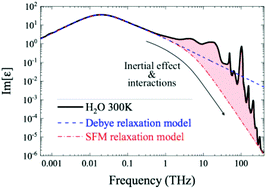Reconsideration of the relaxational and vibrational line shapes of liquid water based on ultrabroadband dielectric spectroscopy†
Abstract
The Debye relaxation function is widely used to describe the large dielectric dispersion of ambient water around 20 GHz. However, from a theoretical point of view, this function is supposed to give incorrect predictions at high frequencies owing to the inappropriate assumption that inertial effects and intermolecular interactions do not affect the relaxation dynamics. Our ultrabroadband spectroscopy investigation of liquid water ranging from 500 MHz to 400 THz did demonstrate that the Debye function is inaccurate far above the microwave region. As an alternative, we tried a stochastic frequency modulation (SFM) model assuming instantaneous modification of the line shapes by the correlation with the surrounding system. The SFM relaxation model reproduced the experimental dielectric spectra up to 400 THz, showing that the hydrogen-bond dynamics are associated with the inertial effect that causes the non-exponential relaxation behaviour in a very short time (typically 25 fs). Within the framework of this relaxation model, the hindered translation modes are able to be approximated as fast modulation (homogeneous) line shapes because the interaction time with frequency modulation is too short. Compared with them, the libation mode is found to have a relatively slow modulation (inhomogeneous) origin, where disturbance of water hydrogen bonds induced by the hindered translations leads to fluctuations in the libration frequency.

- This article is part of the themed collection: 2018 PCCP HOT Articles


 Please wait while we load your content...
Please wait while we load your content...
